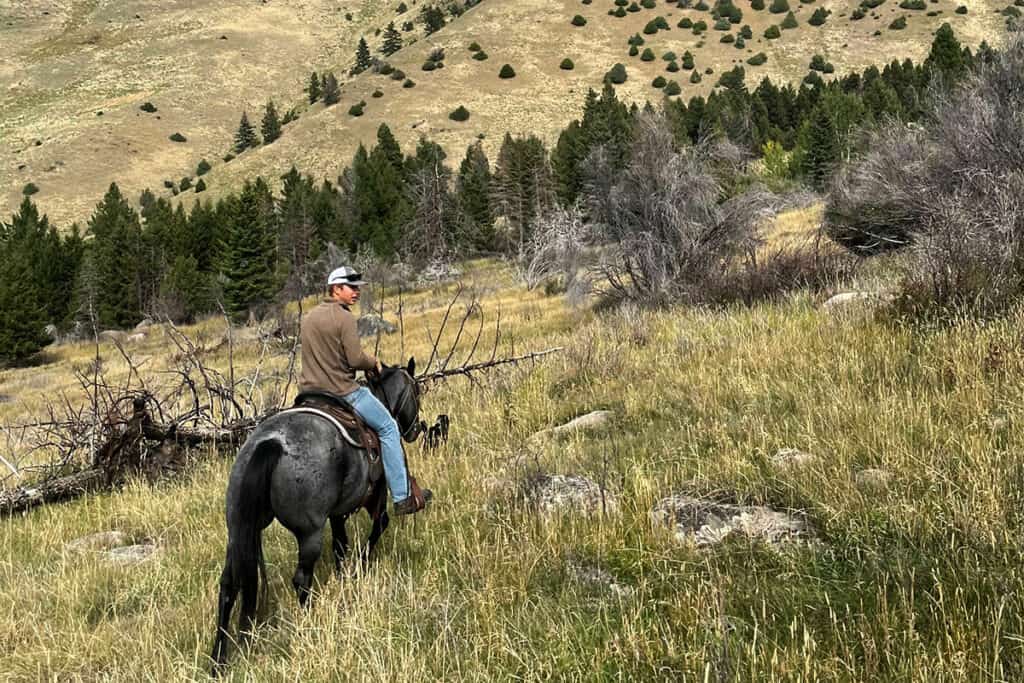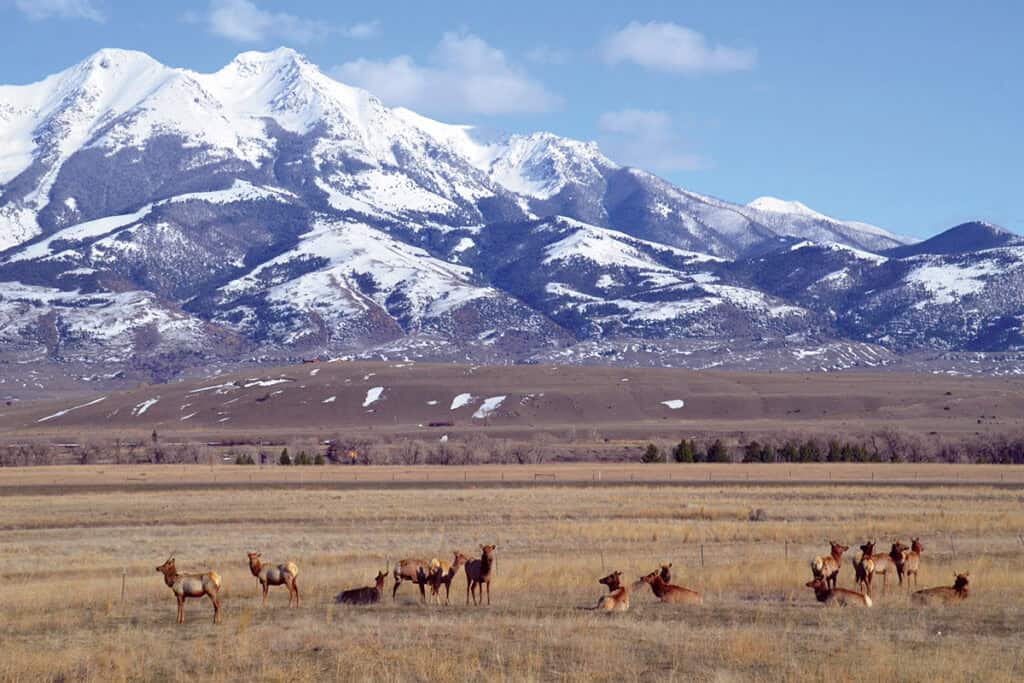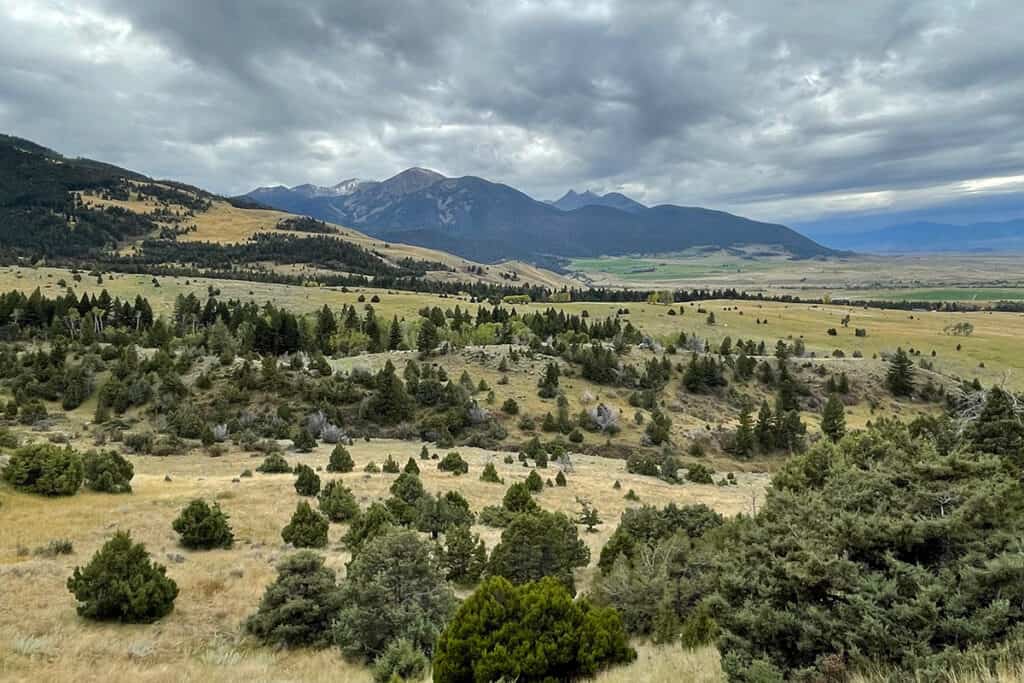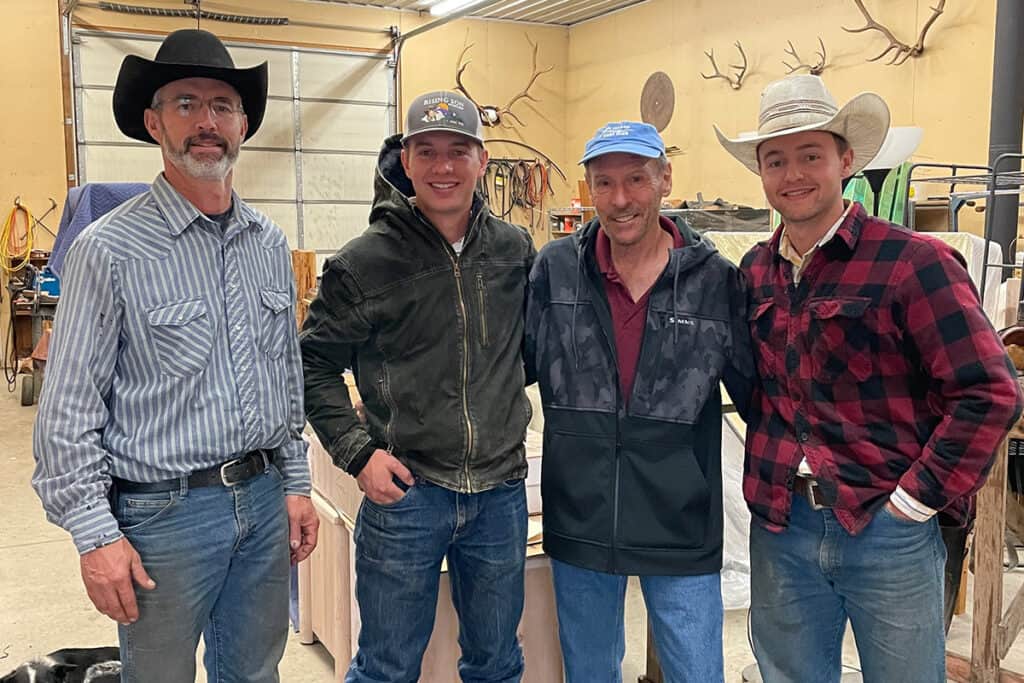
This special issue of PERC Reports features several pilot projects from PERC’s Conservation Innovation Lab. Read the full issue.
“If he starts to gallop, just stand up.” That advice stuck with me as I began my outing on Big Jim. The determined stallion fought my grip on his reins to reach for a bite of bluebunch wheatgrass. I had never been on a horse before, and today I was getting a crash course.
As we traversed steep hillsides and descended into deep gulches, Zane Petrich, one of three sons working alongside their father to run the Petrich Ranch, explained how important fostering native forage is. “When my grandfather first purchased this land,” Zane said, “he’d see eight elk or so in this area. Today, we regularly see 50 to 800 elk.”
Zane attributes this remarkable recovery of wildlife to their stewardship practices. By restoring native vegetation to the landscape, the Petriches have attracted more wildlife to their ranch, a benefit to their business outfitting hunters—but a potential liability for their cattle operation.
Providing wildlife habitat is no easy task for ranchers and farmers here in Paradise Valley, Montana, where development pressure and wildlife conflicts collide to create a unique set of challenges. How to conserve this landscape—and the wildlife it supports—is a vexing question at the center of conservation debate in the region. As traditional conservation tools seemingly reach their limits, creative alternatives have begun to sprout.
One is PERC’s “elk occupancy agreement,” a flexible habitat lease that acknowledges the vital role Montana’s private landowners play in conserving open space by compensating them for their efforts. The simple idea has significant potential to help shape the future of places like Paradise Valley.
Two years ago, PERC and the Greater Yellowstone Coalition partnered with the Petrich family to set aside a portion of their ranch as winter elk habitat. The project was straightforward: install 1.25 miles of wildlife-friendly fencing, and then implement several specific management practices to benefit elk. Whereas wildlife had previously competed for forage with livestock, the fence now sets off nearly 500 acres exclusively for elk and other wildlife. The project is entirely voluntary, privately funded, and the first of its kind in Montana.
Paradise Found
Paradise Valley, a once quiet corner of the West, has been discovered. Nestled between Livingston—a small town that has historically been a haven for artists and writers—and Yellowstone National Park—which sees an average of roughly 4 million visitors annually—the area managed to remain a quiet ranching community for generations.
Today, however, the changes brought by a dramatic influx of people to Montana, which climaxed with the out-migration from major American cities during the Covid pandemic, are evident. As the western aesthetic popularized by television shows such as “Yellowstone” draws a seemingly never-ending stream of visitors to The Last Best Place, local communities like Paradise Valley feel the pressure. Tourism brings in billions to the Treasure State annually—an estimated $8.8 billion in 2022—and is a growing component of the local economy. This popularity, however, brings more than tourism dollars.

Paradise Valley, in particular, has seen a surge in short-term rentals as the area has grown in popularity for investment properties. Likewise, home prices in the region have increased rapidly in recent years, pricing out many locals as wealthy outsiders buy up parcels to build rentals, second homes, and ranchettes. With each new construction project, fences are erected, cars are added to Highway 89, and more people step foot into the surrounding wilderness. Today, Paradise Valley and its large, open land holdings risk being subdivided into a web of development. All of this activity complicates the lives of not only the local people but the local wildlife as well, eating up available habitat and obstructing critical migration corridors for wildlife like elk.
The impacts stretch beyond the valley. The Greater Yellowstone Ecosystem is one of the world’s largest mostly intact temperate ecosystems. Myriad wildlife unique to North America depend on the ecosystem for their migration, and therefore for their survival. It encompasses roughly 22 million acres and is home to one of the largest elk herds in North America, as well as one of the densest populations of grizzly bears in the lower 48. A stealthy visitor might even be lucky enough to spot elusive wolverines or lynx.
Paradise Valley, therefore, isn’t simply a trendy western tourist destination; it is a critical artery for wildlife migration in the region. A blockage would not only disrupt the local flora and fauna, but it would also threaten the health of the broader ecosystem.
With roughly half of Paradise Valley privately owned, conserving this landscape and the migration paths that traverse it will require the cooperation of the landowners who actually live and work here.
“Just like a pulmonary or circulatory system in the human body,” says Arthur Middleton, “if you have a blocked or clogged artery or obstructed breathing passage, you’re in trouble.” Middleton is a professor of wildlife management and policy at the University of California, Berkeley. “If these migration routes are going to persist, then protecting the pathways where they happen is essential.” With roughly half of Paradise Valley privately owned, conserving this landscape and the migration paths that traverse it will require the cooperation of the landowners who actually live and work here.
Paradise Valley is home to a population of roughly 3,000 to 4,000 elk, comprising four separate subherds of the larger, region-wide herd. Elk from these distinct herds converge on Paradise Valley during the cold season, searching for winter range as the snow begins to fly and they migrate down from Yellowstone National Park and the surrounding mountains. The lower-elevation valley offers better forage for the elk and serves as critical habitat during the winter months. Many of them find refuge on the private lands of the valley like those owned by the Petrich family.
“Elk herds can only be as healthy and as big as their winter range,” says Petrich. “The winter range for elk is all getting subdivided. We’ve always tried to take care of the elk, and do a little bit more and more as we can.”
Cervine Costs
Attitudes toward elk vary in the valley, with some ranchers being more willing to tolerate their presence than others. But one simple fact isn’t disputed: Elk impose costs.
From forage loss to disease transfer, providing habitat comes with a big price tag. Elk compete for the same forage as cattle, so when hundreds of elk descend on a pasture, ranchers lose money with each bite. Landowners across Montana lose an estimated $31 million in forage to wildlife each year. Similarly, disease transmission is another concern. An outbreak of brucellosis—a reproductive disease that can be transferred from bison and elk to cows—can be financially ruinous.
Between the costly threats of disease, forage loss, and property damage caused by elk, on top of already thin profit margins, the future of ranching in the valley is uncertain. Some ranchers encourage their children to find other careers, not wanting to pass the burdensome torch to the next generation. Others consider taking the tempting offer of selling to developers. With some land in Paradise Valley selling for five figures per acre, the pressure to call it quits and sell is real.

But if more ranchers do succumb to that pressure, and their large landholdings get subdivided and developed, Paradise Valley’s wildlife—its migrating elk herds in particular—will lose their way of life too. The window of opportunity to find solutions is closing. With each passing year, more people move here, and more land is developed. Some conservationists have proposed one-size-fits-all approaches, such as zoning restrictions or other heavy-handed regulatory measures. But locals are wary of these top-down answers, instead seeking something more flexible, nuanced, and tailored.
Amidst this backdrop, PERC began meeting with ranchers in the valley several years ago. What started as kitchen table conversations quickly grew into promising partnerships. PERC helped form the Paradise Valley Working Lands Group as a subcommittee of the Upper Yellowstone Watershed Group to offer a space for ranchers to share their challenges and voice their hopes and needs. After convening the group, PERC put out a call for ideas, encouraging members to propose solutions for their unique circumstances. Twenty-seven-year-old Zane Petrich came forward with a simple idea that could yield big conservation benefits: install wildlife-friendly fencing that would allow elk to migrate to an area of his property that could be set aside as elk winter range.
Tailored Solutions
The Mill Creek basin, where the Petrich Ranch is located, is one of several drainages that feed Paradise Valley. When you explore this rugged landscape, as I did on horseback this fall, you can spot creatures varying from migratory ungulates like elk, mule deer, and bighorn sheep to predators such as black bears, grizzlies, and wolves. The country is steep, with Emigrant Peak—reaching nearly 11,000 feet—towering over the narrow canyon.

The rugged terrain and abundant wildlife make this tough country for raising cattle. The Petriches’ outfitting business has helped them diversify their income and capitalize on their ranch’s unique landscape, but they still must balance the benefits of providing wildlife habitat with the costs it imposes on their cattle operation. They needed to find a way for these two seemingly incompatible enterprises to coexist. That’s the intersection where PERC’s creative approach had the potential to make a powerful impact.
The concept of paying to conserve private land isn’t new, particularly through conservation easements. Such easements generally require a landowner to agree to perpetual prohibitions on specific types of development or land uses on their property. In return, they often receive a combination of tax breaks or monetary compensation. Easements have long been a powerful tool in the conservationist’s toolbox. And this particular tool is quite popular in Montana. The state leads the way nationally in terms of number of conservation easements as well as acres conserved, with over 2.6 million acres set aside today.

Still, the model doesn’t appeal to every rancher and farmer. Because conservation easements are a forever commitment, not all landowners are comfortable with them. Among many landowners, including those in Paradise Valley, there is an appetite for more flexible alternatives.
An elk occupancy agreement does just that. By establishing a more flexible alternative—essentially a habitat lease that can be tailored to each individual ranch—PERC is finding creative ways to address wildlife challenges on private lands, adding another tool to the conservationist’s toolbox.
In the Petriches’ case, installing wildlife-friendly fencing made a world of difference. Migrating elk can become entangled in traditional barbed-wire fences, leading to potentially fatal injuries. The new fence flexes, allowing elk and other wildlife to easily jump over it as the fence bends with them. This ingenious innovation has opened new frontiers for wildlife and livestock to more easily coexist.

In addition to setting aside acreage, the Petriches have conducted several activities to enhance the habitat on the elk parcel, including removing invasive conifers, spraying invasive cheatgrass, using controlled burns, and treating other noxious weeds to improve range conditions. The work helps foster native forage, important for establishing quality wildlife habitat.
Cheatgrass, an invasive species found throughout Montana, thrives in poor conditions. When native grasses are stressed by drought or intensive grazing, cheatgrass can spread rapidly. Its shallow root system allows it to absorb water and nutrients quickly, eventually choking out other native plants with deeper roots. Without those native plants, soil health suffers, and wildlife lose the forage diversity they need to survive. Additionally, cheatgrass has a short life cycle, browning up quickly in the spring and leaving wildlife wanting for nutritious forage during the summer and fall. When cheatgrass proliferates—as it did on the Petrich Ranch prior to PERC’s elk occupancy agreement—wildlife like elk must find forage and habitat elsewhere.
Removing invasive species and restoring native plant life is expensive and time-consuming. The invasive grasses will take several rounds of treatment and multiple seasons to fully die off. And controlled burns can only be done during select windows of opportunity when the weather cooperates. But this hard work is already paying off. As we rode through the winter range parcel, we could see the green shoots of native grasses returning, slowly displacing invasive ones. Elk trails zigzagged along the mountainside, and tracks littered the soft earth. Wildlife abounds once again.
No two elk occupancy agreements, or habitat leases more generally, will look the same. The very features that make the approach attractive—flexibility and adaptability—mean each agreement will be customized to the needs of the individual rancher in question.
Zane and his brothers demonstrate how the younger generation is thinking creatively about the future, wanting to balance their heritage of ranching with the needs of the ecosystem. They don’t want to sell out and see their land developed, nor do they want to see the landscape they love be permanently altered. They’re motivated to make this work and willing to experiment with creative solutions. It’s innovative conservation approaches like this that will be needed to balance stewardship of wildlife with the new and growing demands on the West.
Innovating Abundance
No two elk occupancy agreements, or habitat leases more generally, will look the same. The very features that make the approach attractive—flexibility and adaptability—mean each agreement will be customized to the needs of the individual rancher in question (see Todd Wilkinson’s feature story for another example). And in this corner of Montana, they can be tailored to address the specific challenges facing the people who make up this valley.
Ultimately, PERC’s vision for how to conserve the best of Paradise Valley is for individual solutions to add up to a powerful cumulative effect. Voluntary exchange can build an ecosystem of conservation that pays. That’s what it will take to conserve the rugged, open landscapes of this valley and others like it. Ranchers and farmers are partners in conservation, but we can’t expect them to shoulder the full burden of providing habitat while resisting development pressure. They should be compensated for their efforts.
PERC’s first elk occupancy agreement demonstrates that conserving this landscape has value. By channeling the private resources of people who care about wildlife into ranching operations that can provide wildlife habitat, we unlock a new model of market-based conservation. Ultimately, when conservation makes economic sense to those doing the conserving, wildlife become an economic asset to be fostered rather than a liability to be avoided. And for the elk in Paradise Valley, that distinction can mean the difference between a future of peril or one of abundance.




